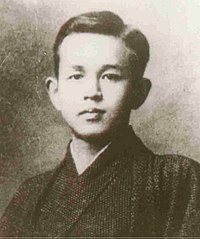Takuboku Ishikawa
This article includes a list of general references, but it lacks sufficient corresponding inline citations. (May 2012) |
Takuboku Ishikawa (石川 啄木, Ishikawa Takuboku, February 20, 1886 – April 13, 1912) was a Japanese poet. He died of tuberculosis. Well known as both a tanka and "modern-style" (新体詩, shintaishi) or "free-style" (自由詩, jiyūshi) poet, he began as a member of the Myōjō group of naturalist poets but later joined the "socialistic" group of Japanese poets and renounced naturalism.
Major works
His major works were two volumes of tanka poems plus his diaries:
- Ichiaku no Suna (A Handful of Sand) 1910
- Kanashiki gangu (Sad Toys) published posthumously in 1912
Diaries
Ishikawa wrote some his diaries in the Latin script transliteration of Japanese so that his wife could not read them.[1]
Timeline

- 1886 - Born at Joko Temple, Hinoto-mura (presently named Hinoto, Tamayama-mura), Minami-Iwate-gun, Iwate Prefecture, to Ittei, the father, who was the priest of the temple, and Katsu, the mother.
- 1887 - Moved to Shibutami-mura (presently named Shibutami, Tamayama-mura)
- 1891 - Attended Shibutami Elementary School (4 years)
- 1895 - Attended Morioka Upper Elementary School (2 years)
- 1898 - Attended Morioka Middle School
- 1899 - Published literary booklet “Choji-kai”, printed by hand with method called hectograph
- 1900 - Formed self-study group “Union Club” in order to learn English. First and second issues of “Choji Magazine” were published. Fell in love with Setsuko Horiai who was a student at Morioka Girls’ Middle School.
- 1901 - Published the third issue of “Mikazuki” (crescent moon), a magazine for circulating, and the first issue of “Nigitama.” His tankas appeared on Iwate Nippo (news paper) under the pen name of “Suiko”, the first public appearance of his works.
- 1902 - His tankas appeared on “Myōjō”, a literary magazine, under the pen name of “Hakuhin”. Dropped out of Morioka Middle School because of his aspiration for literature. Went to Tokyo and made the acquaintances of Tekkan and Akiko Yosano.
- 1903 - Went home to Shibutami. Serial articles “Ideas of Wagner” appeared on Iwate Nippo. Poem ”Shucho” (sorrowful melodies) was appeared on “Myōjō”. The pen name of “Takuboku” was used for the first time. In November, joined the circle of poets “Shinshisha”.
- 1904 - Serial articles “Senun Yoroku” (personal memorandum of war time) appeared on Iwate Nippo. This was right after the outbreak of Russo-Japanese War.
- 1905 - The first collection of poems “Akogare” (admiration) was published by Odajima Shobo. Got married to HORIAI Setsuko. Published literary magazine “Sho-Tenchi” (small world).
- 1906 - Became a substitute teacher at Shibutami Upper Elementary School. Novel “Kumo wa Tensai dearu” (the clouds are geniuses) was written, which was never published during his lifetime. Novel “Soretsu” (funeral procession) appeared on literary magazine “Myōjō” (December issue of 1906).
- 1907 - Became a substitute teacher at Hakodate Yayoi Elementary School, and a freelance reporter at Hakodate Nichinichi Shinbun (news paper). There at the Hakodate Yayoi Elementary School, he met Chieko Tachibana, who he was instantly awestruck by her beauty. Although Takuboku only encountered Chieko in person twice, she left a lasting impression on him, and 22 of the tanka written in "Wasuregataki-Hitobito" in "Ichiaku-no-Suna" were written about Chieko Tachibana. Later despite efforts to visit Chieko in her home in Sapporo, to pursue courtship, he had learned from her father that she had recently been married. Because of the great fire in Hakodate, he lost both jobs and left Hakodate. Employed at places like Hokumon Shinpo or Otaru Nippo (publishers of news paper)
- 1908 - Employed at Kushiro Shinbun (news paper), wrote “Benifude-dayori”. Moved to Hongo, Tokyo in spring.
- 1909 - Employed at Asahi Shinbun as a proof reader. Issued literary magazine “Subaru” as a publisher.
- 1910 - First collection of tankas “Ichiaku-no-Suna” (a fistful of sand) was published by Shinonome-do Shoten.
- 1911 - Moved to Koishikawa because of health reasons.
- 1912 - In March, his mother Katsu died. He himself died of tuberculosis on April 13, being looked after by his friend Bokusui Wakayama and his wife Setsuko, at age of 27. After his death, his second collection of tankas “Kanashiki Gangu” (grieving toys) was published by Shinonome-do Shoten.
- 1926 - In August, his grave was erected by both Miyazaki Ikuu, his brother-in-law, who was also a poet, and Okada Kenzo, the chief of Hakodate Library.
- 1988 - The main-belt asteroid 4672 Takuboku (1988 HB) is named in his honor.
References
- ^ "Ishikawa Takuboku". Encyclopædia Britannica. Retrieved 10 May 2012.
- Ishikawa Takuboku, On Knowing Oneself Too Well, translated by Tamae K. Prindle, Syllabic Press, © 2010. ISBN 978-0-615-34562-8
- Ishikawa Takuboku, Romaji Diary and Sad Toys, translated by Sanford Goldstein and Seishi Shinoda. Rutland, Charles E. Tuttle Co. 1985.
- Ishikawa Takuboku, Takuboku: Poems to Eat, translated by Carl Sesar, Tokyo. Kodansha International, 1966.
- Ueda, Makoto, Modern Japanese Poets and the Nature of Literature, Stanford University Press © 1983 ISBN 0-8047-1166-6 [Ishikawa Takuboku is one of the eight poets profiled in the book, with forty two pages devoted to him. There are nine "free-style" poems and thirty one tanka included in the commentary.]
External links
Wikiquote has quotations related to Takuboku Ishikawa.
Wikimedia Commons has media related to Takuboku Ishikawa.
